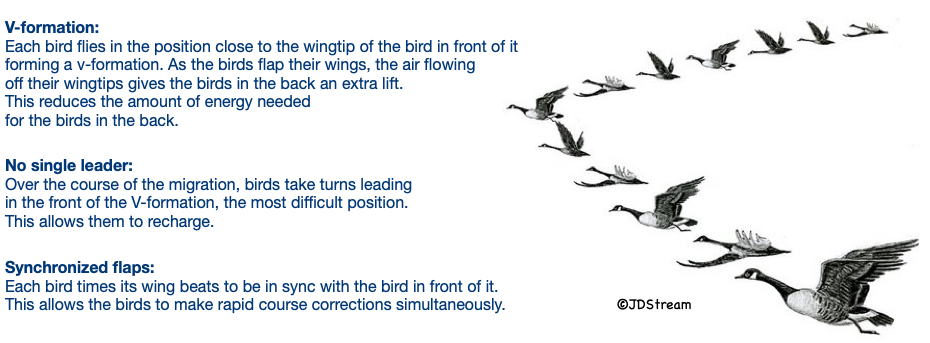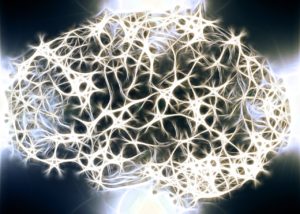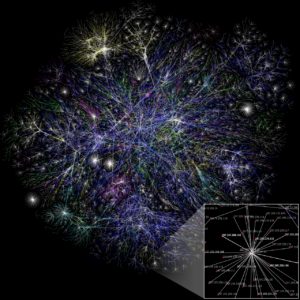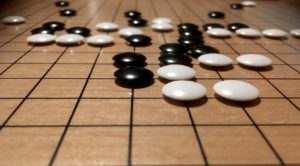What do a flock of birds, the brain, the immune system, the internet and the board game Go have in common? What about intelligence, love, or suffering? How is a space rocket different? These are the topics of complexity science or the science of complex systems. Understanding complex systems is essential to understanding and managing the problems we face collectively.
A system is generally defined as “a collection of interacting elements that together produce, by virtue of their interactions, some form of system-wide behaviour” (Melanie Mitchell, Complexity: A Guided Tour, 2010, p297). In this blog post, ‘part’ will be used interchangeably with ‘element’.
The Murmuration of Starlings
I was working in downtown Toronto from late 2009 to early 2014 in a high-rise glass building off Dundas Square, a public open space near the financial district. The building has floor-to-ceiling windows all around. I had a window seat on the 22nd floor.
On one gloomy afternoon in late 2012, I was startled to see thousands of birds flocking and swarming in front of me, just outside the windows. Having never seen anything like it, nor read or heard anything about birds, I was somehow frightened, but also intrigued, as I watched the birds miraculously swooping away in unison and swirling into arrays of fluid and beautiful shapes as if performing a synchronized dance in the open grey sky. (Check out some of the amazing photos of starlings’ murmuration or this video from the National Geographic.)
With an eerie feeling, I googled the phenomenon…. Long story short, I discovered complexity science and systems thinking. I was hooked.
Thanks to the collaboration of experts across time, space and disciplines. We know how individual starlings operate to generate this mesmerizing phenomenon without crashing into each other. Surprisingly, there is no divine intervention. Each starling responds only to local movements, the movements of the closest six or seven starlings, matching their direction and speed.
Subsequently, I discovered that a flock of migrating birds operated similarly.
A Flock of Migrating Birds:
We have all seen that migrating birds fly in a V formation, but we weren’t quite sure why until fairly recently. The mystery was revealed by scientists from the Royal Veterinary College in 2014 (V-formation flight explained). Similar to starlings, migrating birds follow a few simple rules and self-organize when flying. The illustration below explains the rules.

What’s interesting is that no single bird would be able to make the long journey by itself. However, by flying together with a few simple rules, there emerges a remarkable capability of the migrating birds as a whole. The whole is truly greater than the sum of its parts!
Starlings’ murmuration and a flock of migrating birds are classic examples of complex systems where large numbers of relatively simple agents self-organize by following simple rules that, collectively, create complex patterns of behaviour to adapt to their ever-changing environments. The same phenomenon is also found with ant colonies and swarms of fishes.
Surprisingly, the brain and the immune system share the same properties with ant colonies and other complex systems in nature.
The Brain and the Immune System

The brain has billions of cells called neurons. Each neuron individually is quite simple compared to the brain as a whole. Scientists have discovered that phenomena such as love, intelligence, happiness, suffering, and consciousness do not arise from a single location in the brain (or the human body). It is the neural network, the interactions of the neurons, that creates such phenomena. We still don’t know how those phenomena arise from just the simple neurons talking to each other without any central control in the brain. (David Eagleman, Livewired: The Inside Story of the Ever-Changing Brain, 2020)
Like other complex systems in nature, the brain is also remarkably adaptive. Brain plasticity, the ability of the brain to rewire itself, learn, adapt, and implement changes, is well documented. For example, for people who lost sight later in life (were not born blind), it is shown that the visual connections in their brain are often rerouted to help process auditory information instead. (Norman Doidge, The Brain that Changes Itself, 2007.)
Similar to the brain, the immune system consists of billions of cells that are relatively simple but collectively give rise to a very complex defence network that keeps us from getting sick. The cells involved in the immune system act like little soldiers moving around in the body, detecting germs, bacteria, and viruses, and defeating them without any central control.
It is impossible to understand how the brain or the immune system works as a whole by studying single neutrons or single cells. In the Human Genome Project, scientists thought that by building the entire genetic and physical maps of the human DNAs, we would have a complete understanding of how genetics work and discover genes underlying diseases. It turns out that was not quite the case. Knowing the DNA sequence is not nearly enough to understand what makes us unique or prone to certain conditions. For many diseases, the impact of any single genetic variation is usually small. It is the complex interplay between genes and the environment that affect individual risks of developing particular diseases.
The reason the brain and the immune system perform so well is not that they have every variation or possible scenario figured out in a massively comprehensive blueprint. It is quite the opposite. We have yet to fully understand how large numbers of relatively simple entities self-organize without any central control, into an intelligent whole that adapts and evolves.
The Internet and Social Networks

An example of a complex system that we are familiar with is the World Wide Web or the internet. The internet has relatively simple rules or protocols such as TCP/IP, HTTP, and FTP. Anyone can create and post web pages. Web pages are connected by hyperlinks. There is no central control for who can create, post, and link pages. But out of these self-organizing web pages and hyperlinks, many unexpected, large-scale networks of properties arise. The image above is a visualization of the internet connectivity of hundreds of thousands of networks. It looks amazingly similar to the emergent patterns of a complex system.
Social networks such as Twitter, Instagram, YouTube, and Facebook are examples of self-organizing social systems. The rules of interactions are fairly simple, and people of all ages and walks of life can participate in the network. It is worth noting that the impact of the information propagated on social networks is far beyond any individual user. They have changed the very fabric of our societies and our social dynamics.
Whether you love or hate the internet or the social networks, they have decentralized the media and enabled the democratization of information, knowledge, and expertise. Collectively, we have been more empowered than ever before.
The Board Game Go

The game of Go, although deterministic, epitomizes both the simplicity and the complexity of a complex system. Go has remarkably simple and elegant rules, much simpler than the rules of chess or the rules of any sport. And yet out of these simple rules, an immense complexity arises making Go one of the most fascinating board games in the world.
David Silver, a lead researcher on AlphaGo, who beat Lee Sedol, an 18-time Go world champion in 2016, remarked that the rules of Go were so simple that if we were to meet an alien life that we couldn’t communicate with, we would still be able to play a game of Go with them.
AlphaGo’s win over Lee Sedol in 2016 was a pivotal moment in Artificial Intelligence (AI). It was far beyond IBM’s Deep Blue defeating world chess champion Garry Kasparov in 1997 and IBM’s Watson defeating Jeopardy champion Ken Jennings in 2011. In the game of Go, it is infeasible to exhaustively evaluate all 10360 possible moves. (For comparison, there are 10123 possible moves in chess and only about 1080 atoms in the entire known, observable universe.) Due to the level of complexity, AlphaGo cannot depend on retrieving known data alone to win. It needs to judge the overall game board and make decisions for the next move by itself. It also needs to learn from its own mistakes. Learning was built into AlphaGo’s algorithms so that it could deal with uncertainty and unknowns.
There is much debate on AI and the future of the human species. If history has taught us anything, it is that the trend isn’t stopping. Machines are becoming intelligent. We, collectively, are becoming less intelligent compared to other living, complex systems. The question we should ask is not if AI will destroy humanity, but how we can better understand ourselves and build collective intelligence to save humanity with the help of AI.
(On a separate note: I didn’t quite understand why people were crazy about sports for a long time. I had an epiphany one day while researching complex systems. All games have relatively simple rules, and out of these simple rules, a complexity arises making the outcomes of the games hard to predict and thus exciting. We are social beings in a complex, imperfect world full of uncertainty. Games let us escape into a simpler and more orderly world with just the right dose of chaos.)
What Makes a System Complex (vs. Complicated)?
Complex systems (aka, complex adaptive systems) are easier to understand when explained in contrast with complicated systems, with which we are all familiar. Examples of complicated systems include space rockets, airplanes, and motor vehicles, but are not limited to physical systems.
Both complex and complicated systems have many interacting parts, and both have behaviours that the system-as-a-whole exhibits but not the individual parts. What makes the two types of systems different are threefold: 1) how the parts and the system-as-a-whole relate, 2) the nature of the rules of interactions, and 3) how the behaviour of the system-as-a-whole arises.
Here are six interrelated properties of a complex system from the above three perspectives:
1. Holons – The Harmonious Dichotomy of Autonomy and Dependence
This is a rarely mentioned property in discussions of complex systems. But in my humble opinion, it is the most distinctive attribute of a complex system.
In a complex system, each element is simultaneously a whole in itself and a part of a whole at a higher level. That is to say that every individual part is a sub-whole capable of making decisions and interacting with the environment autonomously while playing a dependent part in the collective whole. In philosophy, the term for sub-wholes is holon.
Holon is a concept proposed by Arthur Koestler in his philosophical psychology book, The Ghost in the Machine (1967). It is a combination of the Greek word, ‘holos’ which means ‘whole’, and the suffix from science that implies a part, or a particle as in neutron, proton, or electron.
Koestler took notice that everything in nature is both a whole and a part. For example, atoms, molecules, cells, organs, and life, are nested holons – each is a whole in itself, but atoms are part of molecules that are part of cells that are part of organs that are part of life that are part of the ecosystem. Each human being is a self-governing whole in our own right and a dependent part of one or more systems such as the food chain system and the family system.
When in harmony, holons transcend the duality of autonomy and dependence. They differentiate themselves while integrating with the greater whole. They express themselves while disappearing in a participative medley of the collective whole. When I first saw the starlings in a murmuration outside my office windows, what caught my attention was the collective whole. When a particular bird came close to the windows, it would swoop away almost instantly before I could cast my eyes on it. It is hard to separate the parts from the whole. It is equally hard to divide the whole into its parts.
In contrast, component parts of a complicated system are usually not wholes in themselves capable of independent decision-making. For complicated physical systems, you can separate the parts from the whole or vice versa.
2. Simple Rules of Interaction and Self-Organization
This attribute is often described as self-organization because we tend to analyze things from a functional perspective. However, it may miss the essence of how complex systems work.
Complexity is all about interactions. In a complex system, individual parts interact autonomously according to a few simple rules without a central controller overseeing the collective whole. Simple rules allow parts to self-organize into a coherent whole. Self-organization creates the condition for a decentralized, dynamic and flexible system. The more rules there are, and the more complicated the rules are, the more need for central control and the more rigid the system-as-a-whole becomes.
In contrast, component parts of a complicated system operate as designed through hundreds or thousands of predefined and often complicated rules under the command of a central processing unit.
3. Decentralized Communications and Decision-making
In a complex system, an individual element only takes signals from and bases its decisions on a small number of other elements it happens to interact with, usually in its immediate environment. In other words, communications, information processing and decision-making are decentralized and distributed. It enables rapid decision-making and simultaneous course corrections in an uncertain environment and allows the whole to adapt.
It is especially true in natural systems and biological systems. As we have seen in starlings’ murmuration, each starling responds only to the movements (signals or information) of the closest six or seven starlings.
In a complicated system, communications and decision-making are usually centralized and managed by a central processing unit (CPU). CPU is the brain of all computers, and its job is to carry out commands.
4. Individual Simplicity Generates Collective Sophistication
What makes complex systems fascinating is that each element is quite simple individually, however collectively, they can generate sophisticated, hard-to-predict, and dynamic patterns of behaviour by following a few simple rules.
It is perhaps the most talked-about property in addition to self-organization. As with self-organization, we often describe it from a functional perspective as ‘emergence’ or ‘emergent property’ that can be misleading.
Emergence is a property or a function that only the system-as-a-whole has but not the individual parts. Therefore, emergence itself isn’t unique to complex systems. Complicated systems also have emergent capabilities. For example, a space rocket can go to space, but none of its parts can do that individually. The capability of the space-rocket-as-a-whole is an emergent property that results from the interactions of its parts.
What makes the emergent property of a complex system different from a complicated system is how the emergence comes about. It is not about the function. It is about the synchronous process of responding to the unpredictable environment through self-organization and simple rules of interactions. In a complex system, emergence is not predefined. It is hard to predict when it may arise. It is dynamic as to how it may unfold in the ever-changing environment. It can be counterintuitive at times.
We understand individuals (and small teams) much better than we do large collectives or collective behaviour.
In contrast, the emergent property of a complicated system is predefined and thus is predictable. Individual parts are not all simple, and the rules of interactions are usually complicated and plenty.
5. Adaptation – Collective Intelligence
Adaptation is closely related to emergence. It is manifested through emergence.
Adaptation is the process of change by which individual parts of the system change their behaviour in response to changes in the environment to improve their chances of survival. Therefore, adaptation is the collective intelligence of a complex system.
Although there is no universal definition of intelligence, it is often defined as the ability to adapt to new environments in the context of evolution. It is not what we know, not what we can do, and not the skills we acquired. Intelligence is the process of acquiring new knowledge. As Einstein said: “The measure of intelligence is the ability to change.” We are good at understanding individual intelligence, but we are terrible at understanding collective intelligence.
In contrast, complicated systems have pre-designed patterns of behaviour, and adaptation isn’t expected.
6. Openness
A complex system is an open system, a system that is open to its external environment. Its boundaries are porous and fluid, allowing free exchange of information, energy and materials/matter with the external environment.
All living systems are open systems. The human brain is a beautiful open system with a plastic, evolving boundary. As David Eagleman describes in his book, Livewired: The Inside Story of the Ever-Changing Brain (2020), the brain is live-wired through our experiences and interactions with the world around us. It is “constantly altering its own circuitry to match the demands of the environment and the capabilities of the body”.
In contrast, a complicated system is a closed system that does not interact with its external environment. It has predefined, hard boundaries.
Why is it Difficult to Analyze Complex Systems?
Complex systems are much harder to analyze and comprehend than complicated systems. It is mostly because of how our thinking has been shaped over the last several centuries. The topic is explored in more depth in another post, Thinking Simpler and Yet Deeper. For this post, these points will suffice:
- A perfect understanding of the parts or elements does not convey a perfect understanding of the system-as-a-whole.
- The whole can only be seen or experienced through the interactions of the parts.
- It is difficult to separate the parts from the whole or to divide the whole into parts when analyzing the patterns of behaviour of the whole.
- There is no fixed structure of the system-as-a-whole. Structures manifest as patterns of behaviour, and they are dynamic, hard to predict, and counterintuitive at times.
PS – Cellular Automata
It is unfair to talk about complex systems without mentioning cellular automata, a branch of mathematics that is central to the emergence of complexity science.
Cellular automata are simple mathematical models for systems consisting of large numbers of simple, identical elements with simple local interactions that generate complex dynamic patterns. It is called cellular because it is made up of cells, like points in a lattice, and it is called automata because it follows simple rules.
Stephen Wolfram, a child prodigy, physicist and computer scientist, remarked, “Cellular automata are sufficiently simple to allow detailed mathematical analysis, yet sufficiently complex to exhibit a wide variety of complicated phenomena.” (1983) He spent most of his career studying the dynamics of cellular automata. He published his work in an epic 1,200-page book, A New Kind of Science (2002). Here is a brief history of cellular automata, an excerpt from his book.


Defining complex and complicated systems may be an entry to your blog seies, You defined this difference well, and I spent much time thinking from your post, in order to comment. I got stuck on your opening premise.
…’ Understanding complex systems is essential to understanding and managing the problems we face collectively.’ I agree on the understanding, but not on the managing.
I had many examples to refute managing an open system, but concluded that there may not be outcome guarantees. Risk can be managed in steps, or parts. Attempts can have pride, if one includes failure and humility as potential learning outcomes, for progress.
Maybe my position comes from western training and sitting on the edge of eastern thinking.
I’m happy to hear more of what you have to post and talk about.
Hi Kelly,
Thank you very much for reading my blog post and for commenting on it. I love questions and counter viewpoints. They make me think. Without questions and discussions, a blog would be a monologue.
These blog posts are based on my talks in industry conferences since 2015. There are a few themes that underlie each of my talks including complex systems, thinking in systems, and individual vs. collective. They form the foundation of my talks in the past and will be the core of my blog posts.
To your question about if understanding complex systems would help us manage the problems that we face collectively. I think so. I will elaborate on that in my upcoming post “Not All Problems Are Created Equal”. So you are ahead of me :-). Briefly, the problems we face collectively are complex problems and therefore require an unconventional approach to comprehend. We need to understand the environment where these problems reside and identify the interactions where these problems arise. Complex problems are not the problems of the parts although symptoms may manifest in parts. Complex problems are the problems of the system-as-a-whole.
I will leave it at that. I hope to publish the post I mentioned above in a few weeks. I will let you know.
Thank you again. I hope we can discuss these in person soon. Ciao!